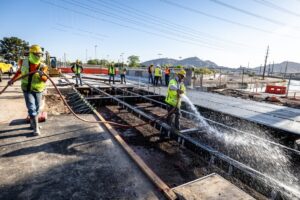Using fiber-reinforced concrete instead of rebar-supported slabs for constructing Metro Phoenix light rail extensions is giving new meaning to rapid transit. Months of construction time are being reduced to weeks, adding cost savings, sustainability and worker safety to the mix.
A collaboration between Arizona State University, the Phoenix Valley Metro Regional Transportation Authority and Kiewit-McCarthy, the project’s construction firm, began with a materials upgrade proposal from Barzin Mobasher, an ASU professor of structural engineering in the School of Sustainable Engineering and the Built Environment.
The project, which extended the light rail by 1.5 miles, incorporated the fiber-reinforced concrete design and was completed in early May.
Reinforcing bar, or rebar, is made of steel and embedded in concrete to strengthen structures. According to Mobasher, more than 60% of the volume of concrete used throughout the world has zero tensile efficiency and is unable to carry load. This makes concrete used in load-bearing structures like the light rail susceptible to cracks, which begin very small and grow unhindered until there is a fault in the structure.
Incorporating rebar provides the loadbearing strength required for most concrete-based construction. However, laying rebar is costly, leaves a dramatic carbon footprint, presents worker safety risks and above all, takes a great deal of time. As the inevitable concrete cracking escalates and the rebar corrodes, additional maintenance, repair and rehabilitation are required, further adding to costs and neighborhood disruption.
Mobasher’s proposal simplified challenges for the light rail extension project and delivered a successful new system “just by making one change in the design criteria – using fibers in the concrete mix instead of reinforcing with rebar,” he said.
Instead of using two layers of rebar in cross directions to support the light rail’s electrified track in the extensions, Mobasher’s design and validation approach considered both steel and polymeric fibers added directly into the concrete, completely eliminating the need for rebar reinforcement. Finally, steel fibers were chosen by Valley Metro for the northwest extension project.
To validate the proposal, a series of serviceability tests were conducted in ASU’s Structural and Materials Lab. Testing involved creating full-size mock-ups for both rebar-reinforced concrete and fiber-reinforced concrete, in the same ratios as full-size sections. Side-by-side testing allowed comparisons of strength and flexibility as well as documentation of concrete cracking and fatigue susceptibility.
The testing process also projected cost and construction time savings. For example, the per mile construction of the extension using rebar was projected at 231 days, while using fiber-reinforced concrete reduced it to 121 days, with a cost savings of more than $12 million.
“The idea of taking several long rebars that are half an inch in diameter, separated by 12 to 18 inches and built into a cage that is 12 inches above ground and replacing them with a fiber material, which is 2 inches long and only 1/32nd of an inch in diameter and mixed in with the concrete, might seem on scale non-competitive,” Mobasher said.
“But if you have thousands of those small fibers distributed in there, they become much more effective in arresting the cracks — working as small Band-Aids to keep the cracks closed and transfer the load. (Fiber-reinforced concrete) can be designed to bear up to an unprecedented 40% of the tensile load capacity of concrete.”
“We did the fatigue tests to simulate conditions for up to 45 years of service at much higher expected loads as proof of concept, and they accepted the proposed approach,” said Mobasher of the approvals from Valley Metro and the city of Phoenix. “It’s been a tremendous experience for them to save the amount of materials used and, at the same time, to be able to meet the project at costs much lower than the original budget and in a much faster time frame.”
The Valley Metro project is expected serve as a prototype for similar light rail upgrades nationally and will be presented at an international Fiber-Reinforced Concrete Workshop hosted by ASU in September.
Construction time
A major obstacle for community approval of light rail transit is months of neighborhood disruption during construction. Using fiber-reinforced concrete instead of rebar-supported designs significantly reduces disruption to weeks or, in some cases, days.
Andrew Haines, project manager for Jacobs Engineering in Tempe, attributed the success of the materials change to “challenging the accepted.”
“There’s an accepted way of doing reinforced concrete in the United States, especially with regard to light rail,” Haines said. “I think engineers get into this track of just, ‘We’ve got to do it a certain way, that’s how it’s always been done,’ and it’s been very difficult to change that — to accept something new.
“The placement of the concrete with the fibers has been very simple,” Haines said. “There’s no reinforcement — there’s no bars in the track slab for workers to try to walk on and perhaps slip on. So, it’s just the prepared earth and the rails are in place and the concrete gets placed around it — the reinforcement is integral with the concrete.”
The ability to develop material samples and test them in the ASU labs was a major component of implementing the change, according to Haines.
“We did all the right things to get this implemented in the field,” he said. “And the result seems to be phenomenal.”
According to Mobasher, the fibers are added into the concrete mix at the plant before being transported by the ready-mix trucks to the construction site. The entire mix is then discharged and self-consolidates, leaving a smooth, finished concrete surface.
“The work that used to take weeks to be done is finished in a matter of hours because we don’t need a crew laying up the steel rebars, connecting them, making sure they are all adequately welded together and that the components are all grounded,” Mobasher said.

















